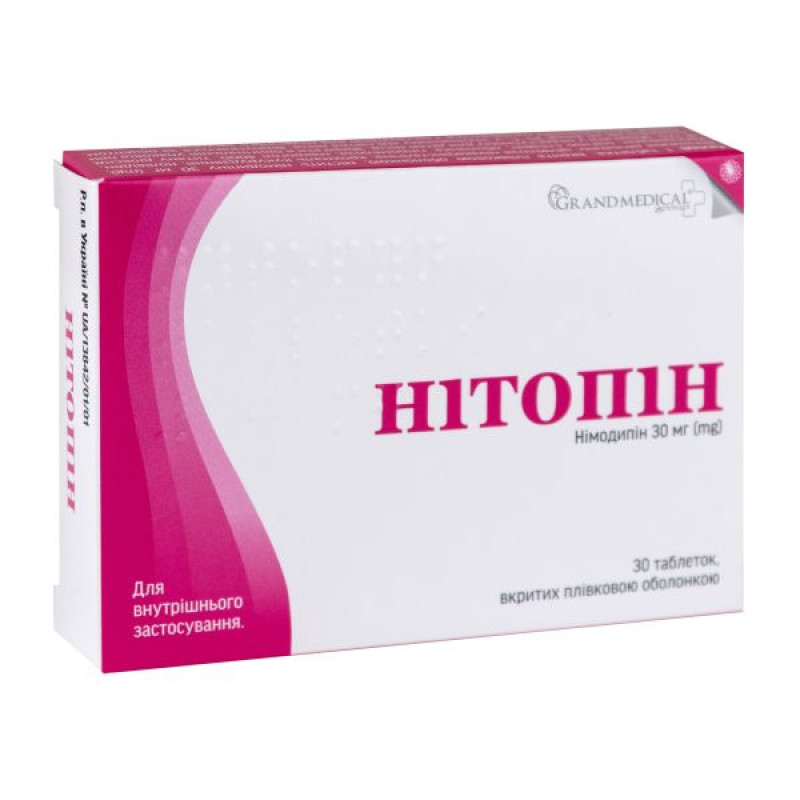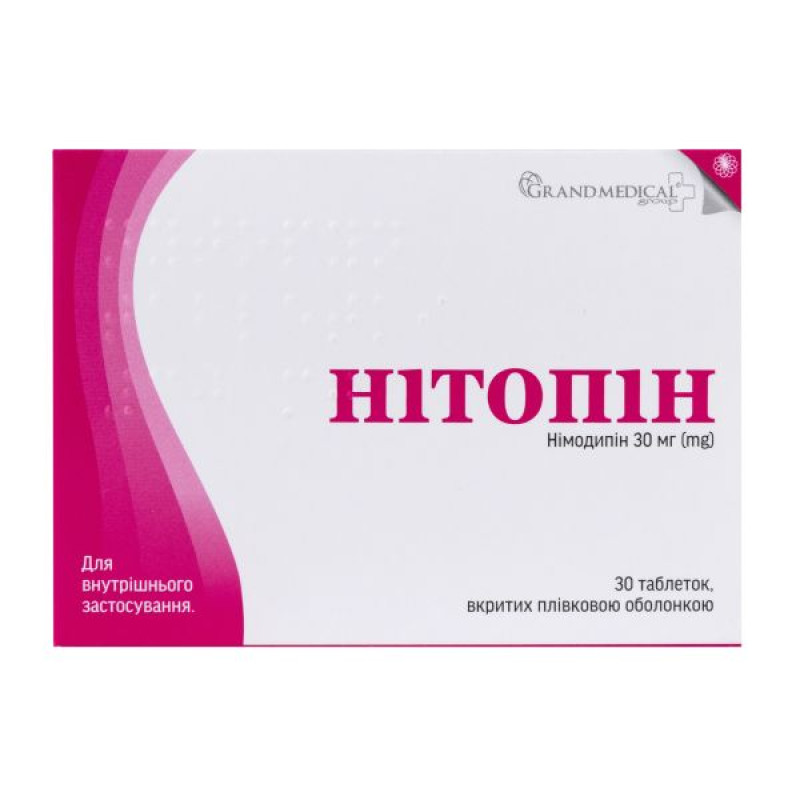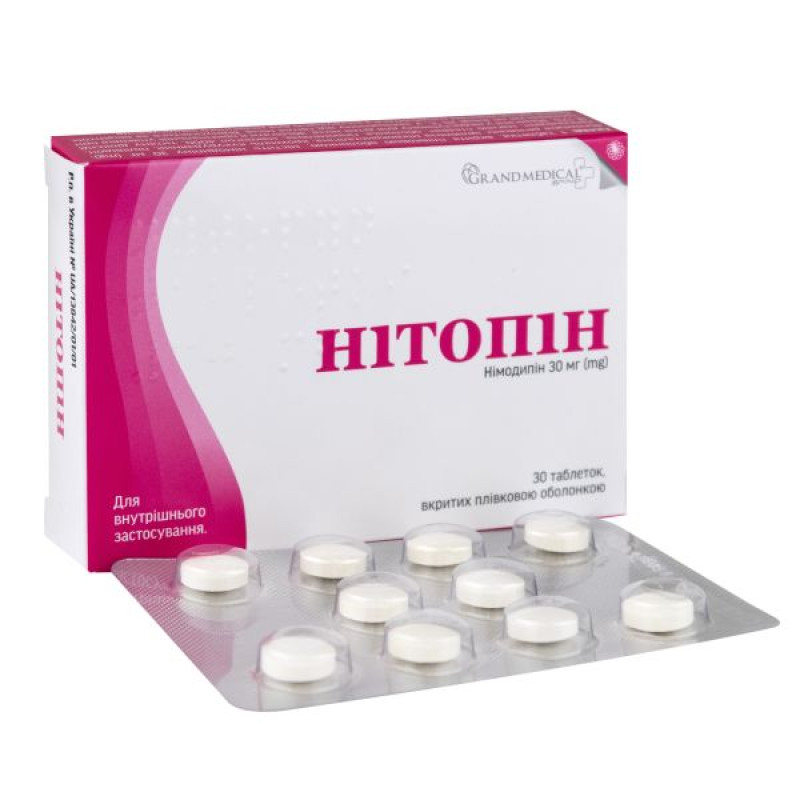Nitopin film-coated tablets 30 mg blister No. 30

Instructions Nitopin film-coated tablets 30 mg blister No. 30
Composition
active ingredient: nimodipine;
1 film-coated tablet contains 30 mg of nimodipine;
excipients: microcrystalline cellulose, corn starch, polyvidone, crospovidone, magnesium stearate;
shell: hypromellose, macrogol 4000, titanium dioxide (E 171).
Dosage form
Film-coated tablets.
Main physicochemical properties: white or yellowish biconvex tablets.
Pharmacotherapeutic group
Selective calcium channel blockers with a predominant effect on blood vessels.
ATX code C08C A06.
Pharmacological properties
Pharmacodynamics
Nimodipine has a pronounced selective effect in certain areas of the brain. Its therapeutic properties are associated with the ability to inhibit the contraction of smooth muscle cells caused by calcium ions.
Nimodipine protects neurons and stabilizes their function; it favorably affects cerebral blood flow and increases tolerance to ischemia through interactions with neuronal receptors and cerebrovascular receptors associated with calcium channels. Other studies have shown that it does not lead to an intracerebral hijacking phenomenon.
Nimodipine has been clinically demonstrated to reduce memory impairment and improve attention in patients with brain dysfunction.
Nimodipine has a positive effect on other typical symptoms, as demonstrated by the assessment of general clinical indicators, the assessment of individual disorders, behavioral observations and psychometric tests.
Pharmacokinetics
The active substance nimodipine is almost completely absorbed after oral administration. Peak plasma concentrations and the area under the concentration-time curve increase in proportion to the dose up to the highest dose tested (90 mg).
The estimated volume of distribution (Vss, two-chamber model) for intravenous administration is 0.9-1.6 l/kg body weight. The total (total) clearance is 0.6-1.9 l/h/kg.
Binding to blood proteins reaches 97-99%.
Nimodipine is eliminated by metabolism via the cytochrome P450 3A4 system.
Due to intensive presystemic metabolism (about 85-95%), absolute bioavailability is 5-15%.
Indication
– Prevention and treatment of ischemic neurological disorders caused by cerebral vasospasm after subarachnoid hemorrhage due to aneurysm rupture.
– Treatment of functional brain disorders in elderly patients with severe symptoms.
Contraindication
Increased individual sensitivity to nimodipine or other components of the drug.
The combination with rifampicin is contraindicated, since the simultaneous use of these drugs leads to a significant decrease in the effectiveness of nimodipine.
Antiepileptic drugs (phenobarbital, phenytoin, carbamazepine) significantly reduce the bioavailability of nimodipine, therefore the simultaneous use of Nitopin with these drugs is contraindicated.
Treatment of functional brain disorders. Severe liver dysfunction, especially in cirrhosis, may lead to increased bioavailability of nimodipine due to reduced completeness of first-pass metabolism and reduced metabolic clearance. Therefore, Nitopin should not be used for the treatment of functional brain disorders in patients with severe liver dysfunction (e.g. cirrhosis).
Interaction with other medicinal products and other types of interactions
Nimodipine is metabolized by the cytochrome P450 3A4 system, which is located in both the intestinal mucosa and the liver. Therefore, drugs that affect this enzyme system may alter the primary metabolism or clearance of nimodipine.
When using nimodipine concomitantly with the following drugs, the degree as well as the duration of the interaction should be taken into account.
Based on experience with other calcium channel antagonists, it is known that rifampicin will enhance the metabolism of nimodipine due to enzyme induction. Thus, the simultaneous use of rifampicin and nimodipine leads to a significant decrease in the effectiveness of the latter. The use of Nitopin in combination with rifampicin is contraindicated.
Prior systematic administration of antiepileptic drugs such as phenobarbital, phenytoin, or carbamazepine significantly reduces the bioavailability of nimodipine tablets, therefore, simultaneous use of the oral form of Nitopin with these drugs is contraindicated.
When using the following inhibitors of the cytochrome P450 3A4 system simultaneously, blood pressure should be monitored and, if necessary, the dose of nimodipine should be adjusted.
No interaction studies have been conducted between nimodipine and macrolide antibiotics. Some macrolide antibiotics are known to inhibit the cytochrome P450 3A4 system and the possibility of drug interactions at this level cannot be excluded. Therefore, macrolide antibiotics should not be used with nimodipine.
No studies have been conducted on the potential interaction between nimodipine and anti-HIV protease inhibitors (such as ritonavir). Drugs of this class are known to be potent inhibitors of the cytochrome P450 3A4 system. Therefore, the possibility of a marked and clinically significant increase in nimodipine plasma concentrations when co-administered with protease inhibitors cannot be excluded.
No studies have been conducted on the potential interaction between nimodipine and ketoconazole. Azole antifungals are known to inhibit the cytochrome P450 3A4 system, and various interactions have been reported for other dihydropyridine calcium channel antagonists. Therefore, a significant increase in the systemic bioavailability of nimodipine due to a decrease in first-pass metabolism cannot be excluded when co-administered with nimodipine tablets.
No studies have been conducted on the potential interaction between nimodipine and nefazodone. The antidepressant is known to be a potent inhibitor of cytochrome P450 3A4. Therefore, the possibility of increased plasma concentrations of nimodipine when co-administered with nefazodone cannot be excluded.
Long-term concomitant use of Nitopin and fluoxetine caused an increase in the concentration of nimodipine in the blood plasma by almost 50%. The effect of fluoxetine was significantly weakened, while the effect of its active metabolite norfluoxetine did not change.
Based on experience with nifedipine, its simultaneous use with quinupristin/dalfopristin may lead to an increase in the concentration of nimodipine in the blood plasma.
Concomitant use of nimodipine and the H2-receptor antagonist cimetidine or valproic acid preparations may lead to an increase in the concentration of nimodipine in the blood plasma.
Long-term use of nimodipine with the antidepressant nortriptyline leads to a slight decrease in nimodipine exposure, while the concentration of nortriptyline in the blood plasma remains unchanged.
Nimodipine, when administered concomitantly, may enhance the hypotensive effect of the following antihypertensive drugs:
– diuretics;
– β-blockers;
– ACE inhibitors (angiotensin-converting enzyme inhibitors);
– A1-antagonists;
– other calcium antagonists;
– α-adrenergic blockers;
– phosphodiesterase-5 inhibitors;
– α-methyldopa.
However, if combinations of this type cannot be avoided, the patient's condition should be closely monitored.
There is evidence that simultaneous intravenous administration of nimodipine and the anti-HIV drug zidovudine leads to a significant increase in the area under the concentration-time curve for zidovudine and a decrease in its volume of distribution and clearance.
Grapefruit juice inhibits the cytochrome P450 3A4 system. The use of dihydropyridines - calcium channel antagonists - simultaneously with grapefruit juice leads to increased plasma concentrations and prolonged action of nimodipine due to reduced first-pass metabolism or clearance. As a result, the hypotensive effect of the drug may increase. After taking grapefruit juice, this effect may last for at least 4 days. Therefore, the simultaneous use of grapefruit/grapefruit juice and nimodipine is not recommended.
Application features
Special warnings and precautions.
Treatment of functional brain disorders
When treating elderly patients, patients with severe renal impairment (glomerular filtration rate less than 20 ml/min) or severe cardiovascular disease, the need for prescribing the drug should be carefully considered and the patient should be systematically examined.
Prevention and treatment of ischemic neurological disorders caused by cerebral vasospasm after subarachnoid hemorrhage due to aneurysm rupture
Close monitoring of the patient is recommended for increased intracranial pressure or increased water content in the brain tissues (generalized cerebral edema), although the use of nimodipine is not associated with increased intracranial pressure.
Treatment of functional brain disorders or prevention and treatment of ischemic neurological disorders caused by cerebral vasospasm after subarachnoid hemorrhage due to aneurysm rupture
The use of nimodipine requires special caution in case of arterial hypotension (systolic pressure level less than 100 mm Hg).
When prescribing to patients with unstable angina or within the first 4 weeks after the development of acute myocardial infarction, the physician should carefully weigh the potential risk (e.g. reduced coronary blood flow and myocardial ischemia) against the benefit of the drug (e.g. improved cerebral perfusion).
Nimodipine is metabolized via the cytochrome P450 3A4 system. Therefore, drugs that affect this enzyme system may alter the primary metabolism or clearance of nimodipine.
Drugs that are inhibitors or inducers of the cytochrome P450 3A4 system may therefore lead to increased plasma concentrations of nimodipine:
– macrolides (e.g. erythromycin);
– anti-HIV protease inhibitors (e.g. ritonavir);
– azole antifungals (e.g. ketoconazole);
– antidepressants nefazodone and fluoxetine;
– quinupristin/dalfopristin;
– cimetidine;
When using these drugs simultaneously, blood pressure should be monitored and, if necessary, a reduction in the dose of nimodipine should be considered.
Use during pregnancy or breastfeeding
Appropriate studies on the effects on pregnant women have not been conducted. If it is necessary to use the drug during pregnancy, the benefits and potential risks of taking the drug should be carefully weighed depending on the severity of the clinical picture.
It has been found that the concentration of nimodipine and its metabolites in breast milk corresponds in order of magnitude to that in maternal plasma. Mothers are not recommended to breastfeed their infants while taking the drug.
In isolated cases, calcium antagonists have been associated with reversible biochemical changes in the sperm head region during in vitro fertilization, which may lead to impaired sperm function.
Ability to influence reaction speed when driving vehicles or other mechanisms
The ability to drive a car or operate other mechanisms may be impaired due to the possible occurrence of dizziness.
Method of administration and doses
Treatment of functional brain disorders
When treating functional brain disorders for elderly patients, the recommended dose, unless otherwise prescribed by a doctor, is 1 tablet (30 mg) of Nitopin 3 times a day.
For patients with significantly reduced renal function (glomerular filtration rate less than 20 ml/min), the need for prescribing the drug should be carefully considered and the patient should be systematically examined.
Prevention and treatment of ischemic neurological disorders caused by cerebral vasospasm after subarachnoid hemorrhage due to aneurysm rupture
After a course of infusion therapy, Nitopin is prescribed orally at a dose of 60 mg (2 tablets) 6 times a day.
In case of adverse reactions, the dose should be reduced, and if necessary, the drug should be discontinued.
Impaired liver function, especially in cirrhosis, may lead to increased bioavailability of nimodipine due to reduced completeness of first-pass metabolism and reduced metabolic clearance. Adverse reactions (e.g., decreased blood pressure) may be more pronounced. In such cases, the dose should be reduced and, if necessary, the drug should be discontinued.
When used concomitantly with CYP 3A4 inhibitors or inducers, dose adjustment may be required (see section "Interaction with other medicinal products and other types of interactions").
The tablets are swallowed whole, without chewing, with a small amount of liquid, regardless of food intake, at intervals of at least 4 hours. It is not recommended to use grapefruit juice simultaneously with the drug.
Children
The drug is not used in children.
Overdose
Symptoms: in acute overdose, arterial hypotension, tachycardia or bradycardia, nausea, and digestive tract disorders are observed.
Treatment: in case of acute overdose, immediate withdrawal of the drug is recommended. In case of emergency care, symptomatic therapy is indicated. As emergency therapy, gastric lavage is recommended, followed by the use of activated charcoal.
In case of a significant decrease in blood pressure, intravenous noradrenaline or dopamine is administered. Since a specific antidote is unknown, symptomatic therapy is also provided in the treatment of other adverse reactions.
Adverse reactions
Adverse reactions associated with the use of nimodipine for the indications "Prevention and treatment of ischemic neurological disorders caused by cerebral vasospasm after subarachnoid hemorrhage due to aneurysm rupture":
from the blood system: thrombocytopenia;
from the immune system: hypersensitivity reactions, skin rashes;
from the nervous system: headache;
from the cardiovascular system: tachycardia, arterial hypotension, vasodilation, bradycardia;
from the digestive tract: nausea, intestinal obstruction;
On the part of the hepatobiliary system: transient increase in liver enzyme activity, including increased transaminases, alkaline phosphatase, gammaglutamyltransferase.
Adverse reactions associated with the use of nimodipine for the indication "Treatment of functional brain disorders in elderly patients with severe symptoms":
from the immune system: allergic reaction, rash;
from the nervous system: headache, vertigo/dizziness, hyperkinesia, tremor;
from the cardiovascular system: increased heartbeat, tachycardia, syncope, edema, arterial hypotension, vasodilation;
from the digestive tract: constipation, diarrhea, flatulence.
Expiration date
3 years.
Storage conditions
Store in the original packaging at a temperature not exceeding 25 °C, in a place protected from light.
Keep out of reach of children.
Packaging
10 film-coated tablets in a blister; 3 blisters in a cardboard box.
Vacation category
According to the recipe.
Producer
Anfarm Ellas S.A.
Location of the manufacturer and address of its place of business
Applicant
Grand Medical Group AG.
Location of the applicant and address of its place of business
Kornmarkt 10, CH-6004, Lucerne, Switzerland.
There are no reviews for this product.
There are no reviews for this product, be the first to leave your review.
No questions about this product, be the first and ask your question.








